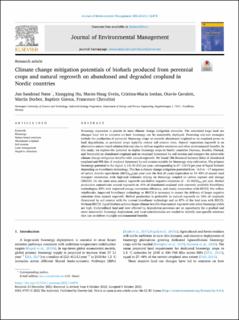| dc.contributor.author | Næss, Jan Sandstad | |
| dc.contributor.author | Hu, Xiangping | |
| dc.contributor.author | Gvein, Maren Haug | |
| dc.contributor.author | Iordan, Cristina Maria | |
| dc.contributor.author | Cavalett, Otávio | |
| dc.contributor.author | Giroux, Baptiste | |
| dc.contributor.author | Cherubini, Francesco | |
| dc.date.accessioned | 2022-11-28T11:27:11Z | |
| dc.date.available | 2022-11-28T11:27:11Z | |
| dc.date.created | 2022-10-23T21:53:27Z | |
| dc.date.issued | 2022 | |
| dc.identifier.citation | Journal of Environmental Management. 2022, 325, Part A, . | en_US |
| dc.identifier.issn | 0301-4797 | |
| dc.identifier.uri | https://hdl.handle.net/11250/3034443 | |
| dc.description.abstract | Bioenergy expansion is present in most climate change mitigation scenarios. The associated large land use changes have led to concerns on how bioenergy can be sustainably deployed. Promising win-win strategies include the production of perennial bioenergy crops on recently abandoned cropland or on cropland prone to land degradation, as perennial crops typically reduce soil erosion rates. Natural vegetation regrowth is an alternative nature-based solution that can also co-deliver negative emissions and other environmental benefits. In this study, we explore the potential to deploy bioenergy crops in Nordic countries (Norway, Sweden, Finland, and Denmark) on abandoned cropland and on cropland threatened by soil erosion and compare the achievable climate change mitigation benefits with natural regrowth. We found 186 thousand hectares (kha) of abandoned cropland and 995 kha of cropland threatened by soil erosion suitable for bioenergy crop cultivation. The primary bioenergy potential in the region is 151 PJ (PJ) per year, corresponding to 67–110 PJ per year of liquid biofuels depending on biorefinery technology. This has a climate change mitigation potential from −6.0 to −17 megatons of carbon dioxide equivalents (MtCO2eq) per year over the first 20 years (equivalent to 14–40% of annual road transport emissions), with high-end estimates relying on bioenergy coupled to carbon capture and storage (BECCS). On the same area, natural regrowth can deliver negative emissions of −10 MtCO2eq per year. Biofuel production outperforms natural regrowth on 46% of abandoned cropland with currently available biorefinery technologies, 83% with improved energy conversion efficiency, and nearly everywhere with BECCS. For willow windbreaks, improved biorefinery technology or BECCS is necessary to ensure the delivery of larger negative emissions than natural regrowth. Biofuel production is preferable to natural regrowth on 16% of croplands threatened by soil erosion with the current biorefinery technology and on 87% of the land area with BECCS. Without BECCS, liquid biofuels achieve larger climate benefits than natural regrowth only when bioenergy yields are high. Underutilized land and land affected by degradation processes are an opportunity for a gradual and more sustainable bioenergy deployment, and local considerations are needed to identify case-specific solutions that can co-deliver multiple environmental benefits. | en_US |
| dc.description.abstract | Climate change mitigation potentials of biofuels produced from perennial crops and natural regrowth on abandoned and degraded cropland in Nordic countries | en_US |
| dc.language.iso | eng | en_US |
| dc.publisher | Elsevier Science | en_US |
| dc.rights | Navngivelse 4.0 Internasjonal | * |
| dc.rights.uri | http://creativecommons.org/licenses/by/4.0/deed.no | * |
| dc.title | Climate change mitigation potentials of biofuels produced from perennial crops and natural regrowth on abandoned and degraded cropland in Nordic countries | en_US |
| dc.title.alternative | Climate change mitigation potentials of biofuels produced from perennial crops and natural regrowth on abandoned and degraded cropland in Nordic countries | en_US |
| dc.type | Peer reviewed | en_US |
| dc.type | Journal article | en_US |
| dc.description.version | publishedVersion | en_US |
| dc.source.pagenumber | 14 | en_US |
| dc.source.volume | 325 | en_US |
| dc.source.journal | Journal of Environmental Management | en_US |
| dc.identifier.doi | https://doi.org/10.1016/j.jenvman.2022.116474 | |
| dc.identifier.cristin | 2064076 | |
| dc.relation.project | Norges forskningsråd: 286773 | en_US |
| dc.relation.project | Norges forskningsråd: 293434 | en_US |
| dc.relation.project | Norges forskningsråd: 257622 | en_US |
| cristin.ispublished | true | |
| cristin.fulltext | original | |
| cristin.qualitycode | 1 | |

